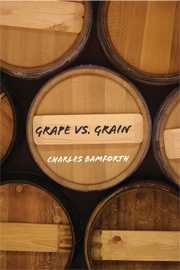Book contents
- Frontmatter
- Contents
- Preface
- Grape vs. Grain
- 1 Beer and Wine: Some Social Commentary
- 2 A Brief History of Wine
- 3 A Brief History of Beer
- 4 How Wine Is Made
- 5 How Beer Is Made
- 6 The Quality of Wine
- 7 The Quality of Beer
- 8 Types of Wine
- 9 Types of Beer
- 10 The Healthfulness of Wine and Beer
- 11 Conclusions about Beer and Wine – and the Future
- Further Reading
- Index
8 - Types of Wine
Published online by Cambridge University Press: 16 September 2009
- Frontmatter
- Contents
- Preface
- Grape vs. Grain
- 1 Beer and Wine: Some Social Commentary
- 2 A Brief History of Wine
- 3 A Brief History of Beer
- 4 How Wine Is Made
- 5 How Beer Is Made
- 6 The Quality of Wine
- 7 The Quality of Beer
- 8 Types of Wine
- 9 Types of Beer
- 10 The Healthfulness of Wine and Beer
- 11 Conclusions about Beer and Wine – and the Future
- Further Reading
- Index
Summary
Wines can be classified in several ways. this may be according to their alcohol content, their color, or the amount of carbon dioxide that they contain. However, most frequently, they are grouped according to their geographic origin (Chablis, Bordeaux, Mosel, Chianti, and the like) or on the basis of the variety of grape from which they are produced. As we saw in Chapter 4, terroir and varietal and an interaction between the two have various degrees of impact on the result in the winery. A single variety grown in different specific locations within a single region may lead to differing end results.
In the United States, it is the norm to label wines on the basis of the grape varietal that enters into their production – Chardonnay and Merlot and Pinot Noir and Zinfandel, and so on. To be named in this way, the wine must feature more than 51 percent of that variety.
As we saw in Chapter 4, the prime species of grape employed worldwide is V. vinifera. Within this species are Muscat-flavored varieties, other varieties with their own distinctive flavors, and some with no distinctive flavors. In turn, within each of these classes are grape types that suit white or red wines. The Muscat varieties, with their characteristic aroma likened to daphne flower, are best suited to dessert wines.
Information
- Type
- Chapter
- Information
- Grape vs. GrainA Historical, Technological, and Social Comparison of Wine and Beer, pp. 129 - 140Publisher: Cambridge University PressPrint publication year: 2008
